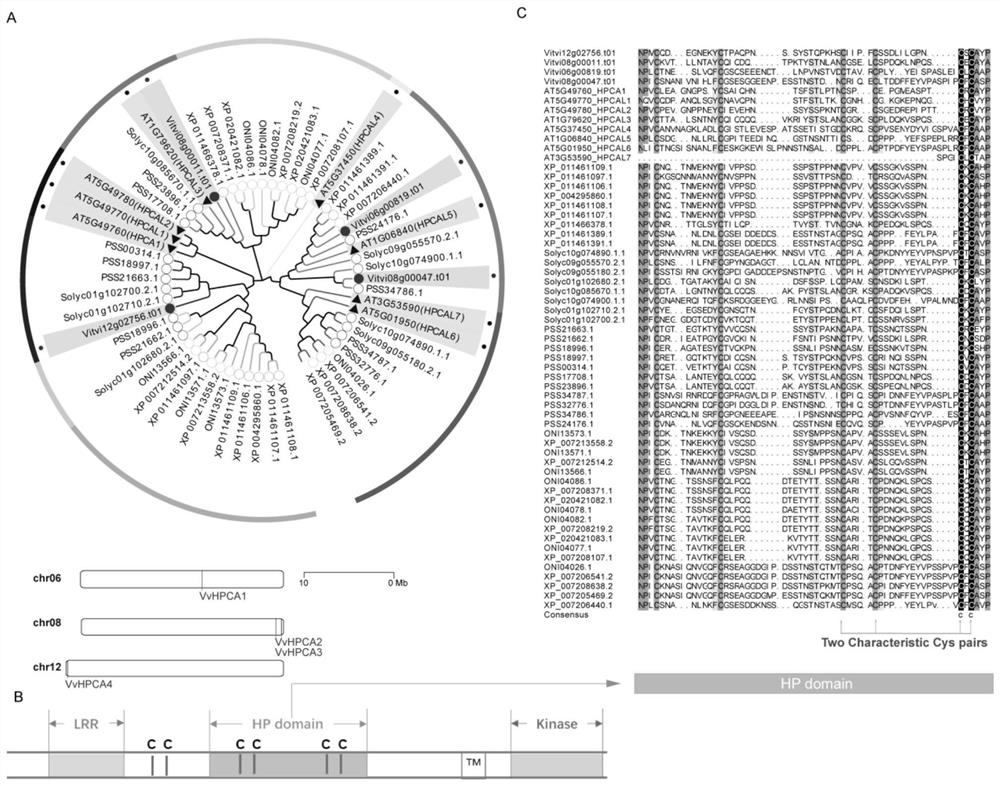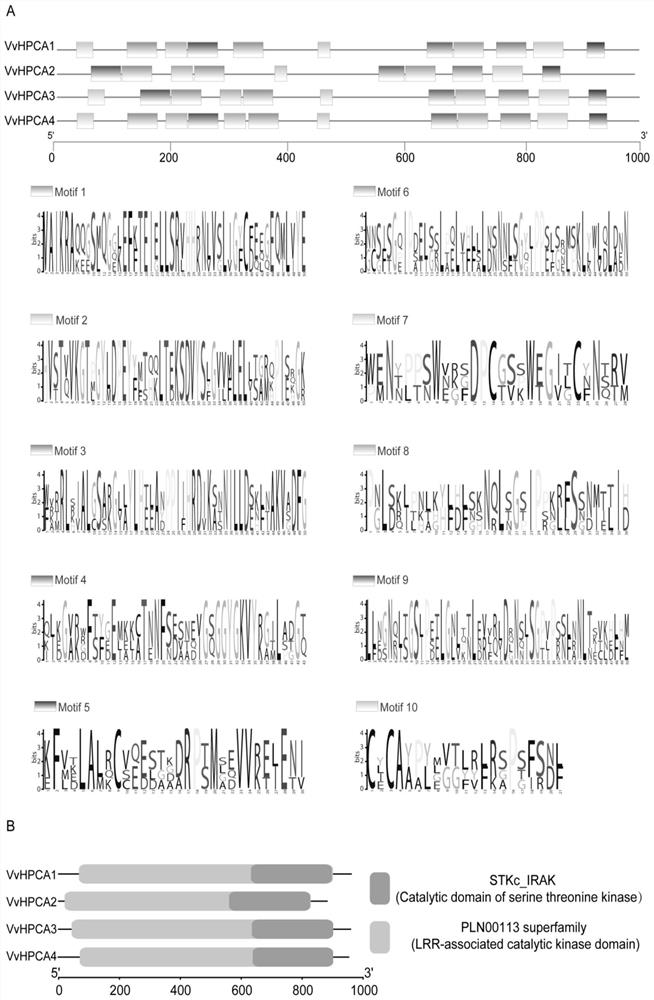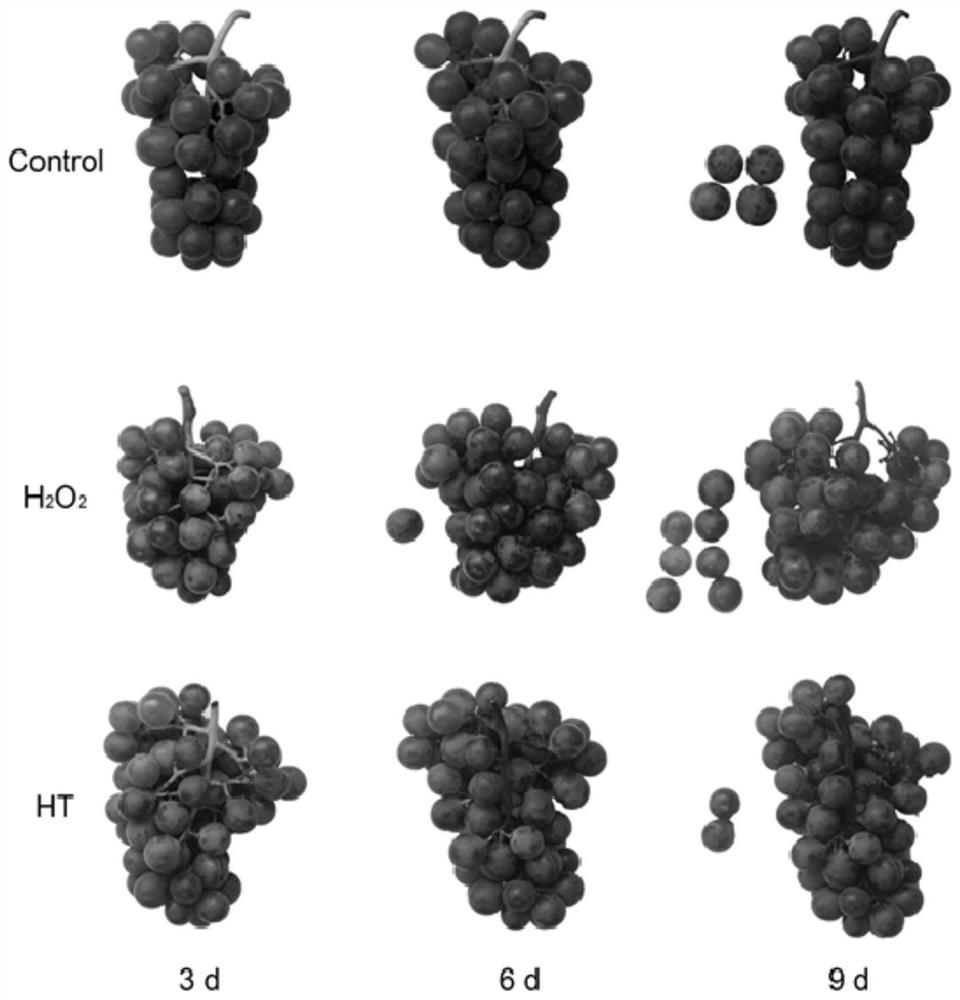Grape hydrogen peroxide receptor gene as well as encoding protein and application thereof
A grape hydrogen peroxide and receptor gene technology, applied in the field of genetic engineering, can solve the problems of hydrogen peroxide receptor distribution and other information expression patterns and subcellular localization are not clear
- Summary
- Abstract
- Description
- Claims
- Application Information
AI Technical Summary
Problems solved by technology
Method used
Image
Examples
Embodiment 1
[0046] Example 1 Identification and Cloning of Hydrogen Peroxide Receptor Members in Grape
[0047] Based on the characteristics of the hydrogen peroxide receptor, we used the grape genome (12X.v2) and the corresponding annotation information (VCost.v3) to perform a local BLAST search for HPCA within the grape genome (the E-value of the search result was less than 0.01), The hydrogen peroxide receptors of grapes were screened out. We identified four hydrogen peroxide receptors VvHPCA1, 2, 3 and 4 from grapevine genome. The MEGA software was used to construct the phylogenetic tree, and the characteristic sequence of HPCA in different species was analyzed by multiple sequence alignment ( figure 1 ). The above results indicate that the VvHPCAs identified in the present invention belong to the LRR-RK family and have a hydrogen peroxide characteristic domain.
[0048] Full-length cloning: high-fidelity DNA polymerase Max DNA Polymerase (Bao Biological Engineering Co., Ltd., Da...
Embodiment 2
[0054] Example 2 Motif and conserved domain analysis of VvHPCAs encoded protein
[0055] The above sequencing results (DNA sequences) were translated into amino acid sequences using Primer Premier v5 software. The amino acid sequence of the VvHPCA1 protein is shown in SEQ ID NO.1, the amino acid sequence of the VvHPCA2 protein is shown in SEQ ID NO.2, the amino acid sequence of the VvHPCA3 protein is shown in SEQ ID NO.3, and the amino acid sequence of the VvHPCA4 protein is shown in SEQ ID NO .4 shown.
[0056] Using the Pfam database (http: / / pfam.xfam.org / search#tabview=tab1), NCBI Conserved Domain Search (https: / / www.ncbi.nlm.nih.gov / Structure / cdd / wrpsb.cgi) and SMART ( Simple Modular Architecture Research Tool) (http: / / smart.embl-heidelberg.de) for LRR-RK and HP domain analysis.
[0057] The results showed that VvHPCAs contained a conserved motif at the C-terminus ( figure 2 A), both contain serine threonine kinase catalytic domain (Catalytic domain of serine threonine...
Embodiment 3
[0062] Example 3H 2 o 2 and ROS inhibitors (hypotaurine, HT) to treat ‘Kyoho’ grapes
[0063] The 'Kyoho' grapes (Vitis vinifera cv. 'Kyoho') were collected during the commercial harvest period, and the grapes with the same ear size and fruit color were selected for processing. Referring to Guo et al. (Transcriptome analysis reveals mechanism of early ripening in Kyoho grape with hydrogen peroxide treatment. BMC Genomics. 21, 784. https: / / doi:10.1186 / s12864-020-07180-y .) method, configure 300mmol L - 1 h 2 o 2 , 150 mmol L -1 HT solution (containing 0.01% Silwet_L-77), with double distilled water as a control, soak the selected ears in the above solution for 15 minutes. Then put it into a fresh-keeping box, cover it with plastic wrap, and store it in a storage room at 25±1°C. The control, H 2 o 2 and HT-treated fruits ( image 3 ), fully frozen with liquid nitrogen and stored at -80°C for subsequent analysis and experiments.
PUM
 Login to View More
Login to View More Abstract
Description
Claims
Application Information
 Login to View More
Login to View More - R&D
- Intellectual Property
- Life Sciences
- Materials
- Tech Scout
- Unparalleled Data Quality
- Higher Quality Content
- 60% Fewer Hallucinations
Browse by: Latest US Patents, China's latest patents, Technical Efficacy Thesaurus, Application Domain, Technology Topic, Popular Technical Reports.
© 2025 PatSnap. All rights reserved.Legal|Privacy policy|Modern Slavery Act Transparency Statement|Sitemap|About US| Contact US: help@patsnap.com



